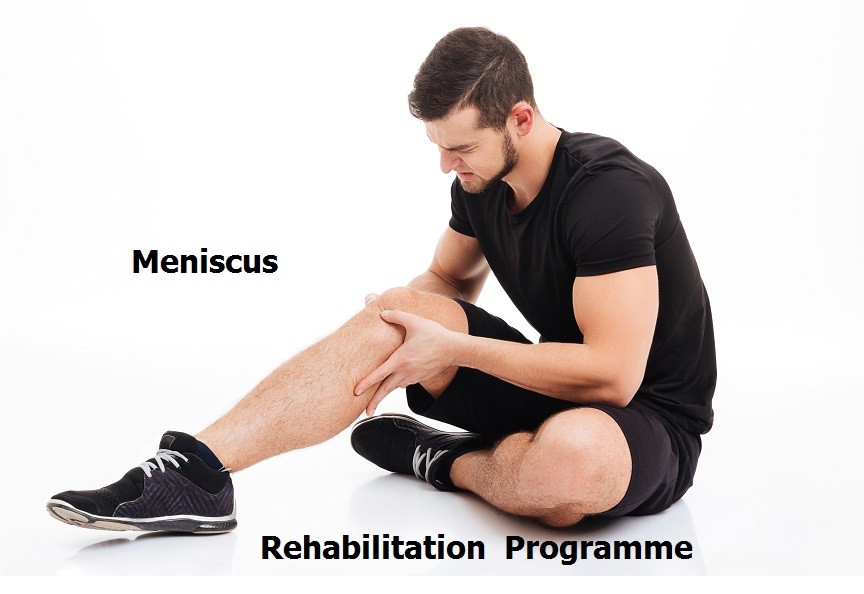Exercises for Knee Meniscus Tear Recovery
Unfortunately, a meniscus tear is the most commonly observed knee injury, which will require a meniscus rehabilitation program in order to become physically active either post-surgery or post-injury.
Experiencing an injury like a meniscus tear can become a major setback regarding your physical fitness, but proper meniscus repair rehab can prevent further injuries, and ensure safety throughout the recovery process.
Becoming intellectually involved with the anatomy, physiology, and healing of a meniscus tear will help you on your own path to recovery.
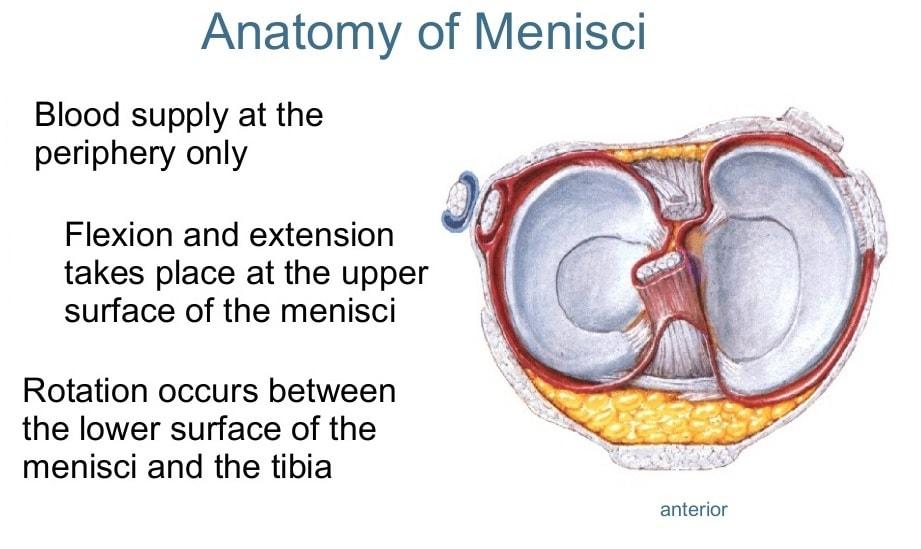
To learn more about how to correctly get back into a workout routine by using meniscus tear rehab exercises, read below.
Are You Suffering FromKnee Meniscus Tear?
If you’ve experienced a meniscus injury, its best to consult with a physician to determine the best prognosis.
The knee joint is a very complex joint and as you can see below there are many types of movements occuring at the knee joint making the knee injury rehabilitation complex.
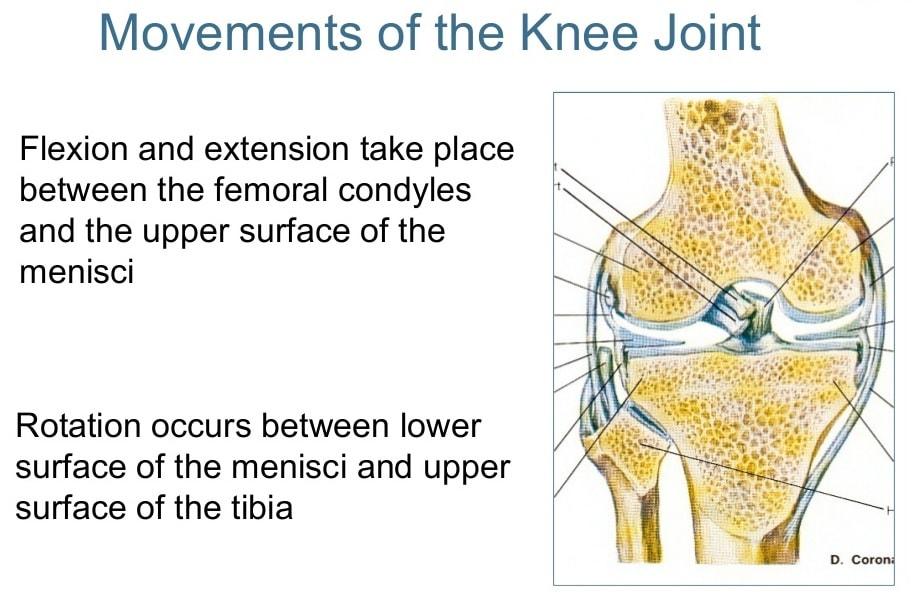
Factors like ligament damage, age, activity level, and existing joint health are inspected to dictate whether or not surgery is the best option [13].
Once you’ve analysed the situation and have chosen the best recovery path for yourself, follow the steps below to get back into fitness with care and safety. It is crucial to continue with your meniscus rehabilitation guidelines to avoid future knee injuries, and keep the joint healthy and active.
Additionally, the benefits of Meniscus tear exercise will further increase your health and injury prevention.
The anatomy of a knee meniscus tear and meniscus repair recovery
The meniscus ligament has many functions, and it is a key element to the musculoskeletal function of the knee.
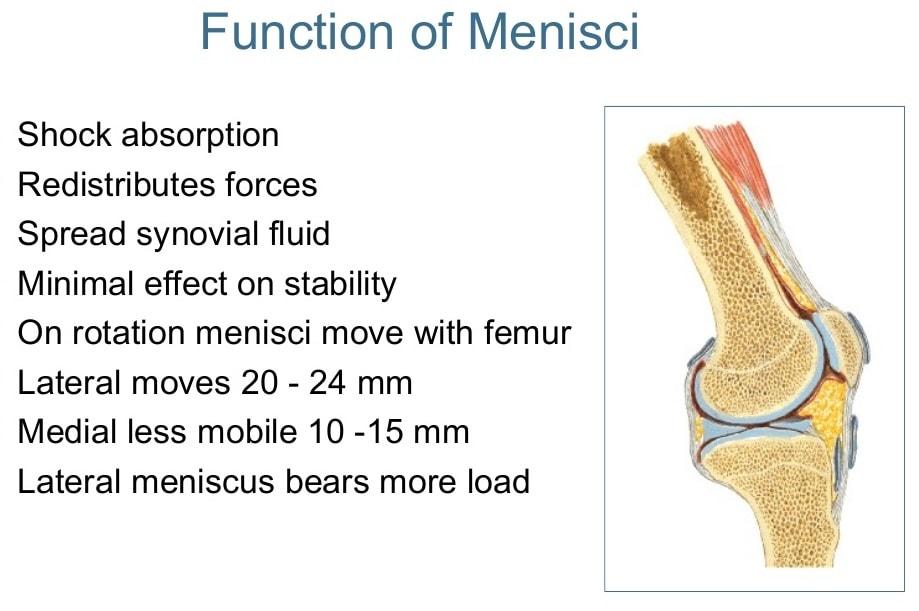
Without this integral ligament, the function of the knee joint would be significantly decreased. Little to no menisci typically leads to arthritis – degenerative joint disease in the knees.
In a knee without a meniscus, the femorotibial joint absorbs 235% more stress [17]. Therefore, preserving these ligaments is crucial to good joint health.
The meniscus is a thin, C-shaped ligament that provides cushion between the condyles of the tibia and the femur, on both the lateral and medial sides of the knee [16]. Meaning there are two separate menisci ligaments.
When uninjured, the menisci have strong and healthy vasculature, or blood supply [2].
These ligaments can be damaged or torn when pressure is put onto a rotating knee, or by sustaining a significant amount of force to the knee joint [1].
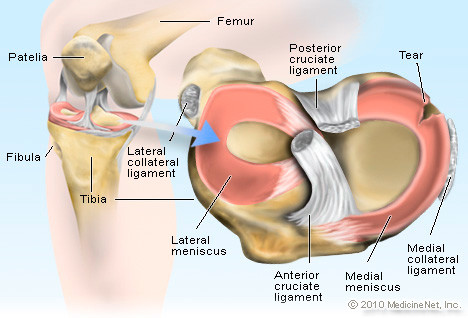
In other cases, meniscus injuries can occur from irregular movement compensations, or wear-and-tear on the joint as we age.
Meniscus tears can be fixed surgically with two techniques. The technique used depends greatly on the presence of the tear.
If a tear is large and a significant piece of the meniscus is intact, the ligament may be able to be reattached and sewn back into place, called meniscal repair.
If the fragmented ligament is too small for stitching, it is removed through a process called a meniscectomy.
Once this fragment of the ligament is removed, it cannot regrow or redevelop.
It is said that lateral meniscectomy has further risks than medial meniscectomy [15].
Some torn meniscus injuries do not require surgery. In these cases, a specific exercise program should be carefully maintained and followed.
Over time, the knee muscles must be strengthened to help prohibit faulty movements of the knee, and increase the knee’s overall stability.
One study even shows better success in knee recovery because of fewer symptoms, like as mechanical problems, swelling, and decreased range of motion [6].
However, a meniscus rehabilitation program must still be followed meticulously to see a 100% recovery.
Surgical method for knee meniscus repair and recovery time
A meniscus repair surgery is an outpatient operation. The first few post-surgical days are necessary for recovery and initial healing.
Usually the range of motion exercises don’t usually begin until one week post-surgery, and at that point, only 90° flexion is advised [14].
As the weeks continue, range of motion can be increased, you can begin to put weight on the leg, and mild stretching exercises are recommended.
Around six weeks’ post-surgery, some exercises can be introduced to begin a strength regimen.
Strength exercises are crucial to reinforce joint stability and balance after you undergo a meniscus tear surgery.
The muscles of the quadricep (rectus femoris, vastis lateralis, vastis medialis) and hamstring are the main supporters of lateromedial knee stability.
Gait retraining, straight leg lifts, knee extensions and hamstring curls are all functional exercises that improves knee stability, circulation, and joint health, and decrease the presence of scar tissue formation.
If exercises are followed carefully, under the care of either a physiotherapist of personal trainer who specialises in injury rehabilitation, full meniscus recovery generally occurs within 6-8 months.
Some individual cases may have varying recovery times depending on surgical complications and underlying knee conditions.
However, once you’re at the 6-8 month-time period of recovery, special attention should be given to returning back to physical activity.
One study supports that eighty-one percent of patients can return back to their previous level of fitness 10.5 months after a meniscus surgical repair [10].
What rehabilitation guidelines should I follow if I didn’t have a meniscus repair surgery?
If surgery was not the best prognosis for your torn meniscus, a slow-progressing exercise routine should be sustained.
To begin, the injured area needs to undergo some healing.
Although you may be weight-bearing, only slight range of motion exercises should be completed to reduce scar tissue and post-injury swelling and improve circulation.
Once the initial tissue trauma has started to heal, you may be able to begin light and gentle exercises [8].
The best and safest way to continue towards an active lifestyle is to work with a sports injury specialist, like an elite personal trainer in London specialised in knee injuries.
Working with an injury specialist will help determine your best meniscus injury recovery strategy.
For example, if you tore the medial meniscus, the vastis medialis may need more strength improvement than the vastis lateralis, and vice versa [3].
Examining other injury factors like posture, compensation patterns, and gait analysis are only a few things which may ensure prevention of a future injury.
Meniscus tears and getting back into a regular workout routine
Whether you have or have not had surgery for your meniscus injury, getting back into a fitness routine needs to be handled delicately and seriously [5].
Over-achieving too soon or putting too much load on the knee only increases your chances of obtaining another injury.
However, it is important to work each day towards being able to sustain a regular workout plan.
Here’s why it’s so important…
Continuing with regular exercise will improve the joint function, circulation, and not to mention the copious amounts of benefits exercise provides (better fitness, toned body, weight loss, better mood, improved memory, strength gains, and increased endurance, to name a few).
When you fail to put in the work required for your rehabilitating meniscus, further mishaps and injury complications will happen at a significantly higher rate [9].
Often times, those who do not participate in regular physical fitness also greatly increase their chances of getting osteoporosis at a younger age [7,12].
Open kinetic chain exercises can be introduced around 6-8 weeks for either post-injury or post-surgery patients, like leg lifts and knee flexion [8].
After eight weeks, closed kinetic chain exercises are recommended, such as half squats, hamstring curls, leg extensions, and hip adduction and abduction [4].
These muscles need to be utilized with these basic exercises before adding weight or completing numerous repetitions.
First, for the healing of the injury, and second, to reduce further complications of a pulled or torn muscle.
What exercises to avoid in your meniscus repair rehabilitation
Because of the injury to the meniscus, some exercises should be eliminated from your workout routine to prevent further damage to the knee joint.
Avoid doing exercises in your meniscus rehab program that put strain on the ankle, such as weighted leg straighteners or weighted hip adduction/abduction [11].
This puts additional force on the tibia, which in turn, stresses the meniscus [17].
Lateral movements, like cone drills and ladder work should be done slowly at first, to ensure stability.
If the knee feels unstable or weak, continue with quad and hamstring strengthening movements.
Avoid moving your injured knee when you are weight-bearing.
The friction of the foot on the floor, and the added rotation is an easy way to cause further damage.
Varying differences among meniscus injuries
Because there is so much variance among torn menisci and their road to recovery, consult with a physician or an elite personal trainer in London to ensure you’re not skipping essential steps of your meniscus repair rehabilitation.
Some individuals may have a less complicated recovery, while others might take months [18].
When your body is ready to resume with a fitness plan, you’ll be able to tell. It’s easy to get impatient while waiting for full recovery, but know that when talking about injuries extra precautions and taking it slow is the fastest way to become healthy and active once again.
In conclusion…
Following these general guidelines can help you manage your way through a meniscus rehabilitation program.
Safety and prevention are the top concerns when advancing towards the end goal of physical fitness and returning to a normal fitness plan.
If you live in London and want to rehabilitate your knee injury I will design your meniscus rehabilitation programme completely customised to your challenges, fitness/health goals and lifestyle needs.
Keen to get started?
Contact me through this link, HERE.
Working with a fitness specialist or someone certified in sport rehabilitation can ensure successful results, and enable a full meniscus repair recovery in the safest and quickest way.
References
- Allaire R, Muriuki M, Gilbertson L, Harner CD. Biomechanical consequences of a tear of the posterior root of the medial meniscus. Similar to total meniscectomy. J Bone Joint Surg Am. 2008 Sep. 90(9):1922-31.
- Arnoczky SP, Warren RF. Microvasculature of the human meniscus. Am J Sports Med. 1982 Mar-Apr. 10(2):90-5. [1]
- Barber FA, Harding NR. Meniscal repair rehabilitation. Instr Course Lect. 2000. 49:207-10.
- Beynnon BD, Johnson RJ, Fleming BC, et al. The strain behavior of the anterior cruciate ligament during squatting and active flexion-extension. A comparison of an open and a closed kinetic chain exercise. Am J Sports Med. 1997 Nov-Dec;25(6):823-9.
- Cavanaugh JT . Rehabilitation of meniscal injury and surgery. J Knee Surg. 2014 Dec;27(6):459-78.
- Frellick M. Exercise as Effective as Surgery for Meniscal Tears. Medscape Medical News. July 21, 2016;
- Hall M, Hinman RS, Wrigley TV, et al. The effects of neuromuscular exercise on medial knee joint load post-arthroscopic partial medial meniscectomy: ‘SCOPEX’, a randomised control trial protocol. BMC Musculoskelet Disord. 2012 Nov 27;13:233.
- Heckmann TP, Noyes FR, Barber-Westin SD: Chapter 30: Rehabilitation of meniscus repair and transplantation procedures. Noyes’ Knee Disorders: Surgery, Rehabilitation, Clinical Outcomes, Saunders, Philadelphia, 2009, pp. 806-817. [3]
- Kise NJ, Risberg MA, Stensrud S, Ranstam J, Engebretsen L, Roos EM. Exercise therapy versus arthroscopic partial meniscectomy for degenerative meniscal tear in middle aged patients: randomised controlled trial with two year follow-up. BMJ. 2016 Jul 20.
- Logan M, Watts M, Owen J, Myers P. Meniscal repair in the elite athlete: results of 45 repairs with a minimum 5-year follow-up. Am J Sports Med. 2009 Jun. 37(6):1131-4. [3]
- Malone, Terry, Turner Blackburn, and Lynn Wallace. “Knee Rehabilitation.” Knee Rehabilitation. Journal of the American Physical Therapy Association, Dec. 1980. Web. 02 Mar. 2014.
- McDermott, I. Meniscal tears, repairs and replacement: their relevance to osteoarthritis of the knee. Br J Sports Med. 2011 Apr;45(4):292-7.
- Mordecai SC, Al-Hadithy N, Ware HE, et al. Treatment of meniscal tears: An evidence based approach. World J Orthop. 2014 Jul 18;5(3):233-41.
- O’Donnell K, Freedman KB, Tjoumakaris FP. Rehabilitation Protocols After Isolated Meniscal Repair. Am J Sports Med. 2016 Oct 1:363546516667578.
- Pena, E., B. Calvo, D. A. Martinez, et al. Why lateral meniscectomy is more dangerous than medical meniscectomy. A finite element study. J Orthop. Res. 24:1001–1010,2006
- Rodkey WG. Basic biology of the meniscus and response to injury. Instr Course Lect. 2000. 49:189-93. [1]
- Vaziri A, Nayeb-Hashemi H, Singh A, Tafti BA. Influence of meniscectomy and meniscus replacement on the stress distribution in human knee joint. Ann Biomed Eng. 2008 May 22. epub ahead of print.
- Zhan M, Evaniew N, Bedi A, et al. Arthroscopic surgery for degenerative tears of the meniscus: a systematic review and meta-analysis. CMAJ. 2014 Oct 7. 186 (14):1057-64.
Disclaimer: This website and all its content is to be used for information purposes only. This website or any of its content or links to third parties does not diagnose, advise, treat or cure any ailments, illness or disease.
You agree to hold harmless the owner of this site for any action taken on your own without consulting your medical doctor first by using the information on the website for diagnostic, treatment, or any other related purposes. This is not medical advice. If you are suffering from any illness, disease or ailments please contact your doctor first and immediately.



